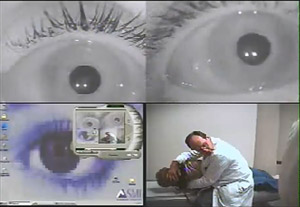
VIDEO – Migrainous Positional Vertigo (MPV): Ear or Brain?
Published on: February 21, 2014
Roberts, Gans and Kastner (2006), von Breveren (2004) and Neuhauser (2001) have all published articles about MPV. The condition is seen almost exclusively in post-menopausal females with history of migraine. At AIB we have seen dozens of patients ranging from 39 to 74 years of age. All had a history of migraine (IHC, 2004) since puberty with a range of manifestations (with and without aura, headache, motion intolerance etc.) typically associated with monthly menses. The majority no longer had the monthly migraine headache since menopause. All however, did report a migraine around the time of the onset of the acute positional vertigo.
Based on the patient’s gender, age and symptoms of acute positional vertigo, they are often initially diagnosed with Benign Paroxysmal Positioning Vertigo (BPPV). The provoked nystagmus direction, however, is typically horizontal (ageotropic) and occurs in lateral body positions. It appears to look more like an HC than PC involvement. Repositioning maneuvers for any canal variant do not extinguish the nystagmus or vertigo. vonBrevern, has speculated the genesis is in the brain, not the ear, likely resulting from dysfunction of inhibitory fibers from the vestibulocerebellar nodulus and uvula to the vestibular nuclei.
CASE STUDY:
66 year-old female. Acute onset of positional vertigo (initial episode with migraine headache), bilateral symptoms, but much more intense lying on her left side. Vertigo is rated at 10 with nausea and emesis is position is maintained.
Please note* VOG mirrors reverse eyes in the video. As you look at patient’s eyes, right eye is to your right.
- When patient lays on her right side, there is a non-fatiguing, ageotropic, left beat nystagmus (LBN). Mild vertigo.
- On left side, there is a 58 deg/sec non-fatiguing, ageotropic nystagmus, right beat nystagmus (RBN). Intense accompanying vertigo.
- Multiple and varied treatments for HC-BPPV (Appiani, Cassani, barbecue roll) are ineffective.
- Patient is prescribed Topamax and is asymptomatic within 36 hours, with complete resolution of symptoms.
Take Home Message: There are numerous underlying conditions that may cause positional nystagmus and vertigo other than BPPV, i.e. MPV, multiple sclerosis, Arnold Chiari, brainstem and cerebellar infarcts, alcohol and pharmacological influences. Therefore, the explanation by clinicians of a “non-classic” BPPV patient should be cautiously accepted in view of the clear mechanical aspects of BPPV versus neurological patterns, especially when symptoms cannot be managed by well-proven repositioning maneuvers.
References:
- Neuhauser, H., Leopold, M., von Brevern, M., Arnold, G. & Lempert, T. 2001. The interrelations of migraine, vertigo, and migrainous vertigo. Neurology, 56, 436/441.
- von Brevern, M., Radtke, A., Clarke, A. & Lempert, T. 2004. Migrainous vertigo presenting as episodic positional vertigo. Neurology, 62,469/472.
- Roberts, R., Gans, R., Kastner, A. 2006. Differentiation of migrainous positional vertigo (MPV) from horizontal canal BPPV (HC-BPPV). International Journal of Audiology, 45:224/226
- Roberts, R. and Gans, R., 2008. Nonmedical Management of Positional Vertigo, in Jacobson G., and Shepard, N. (Eds.) Balance Function Assessment and Management, Plural Publishing, San Diego.